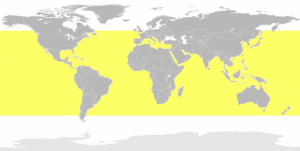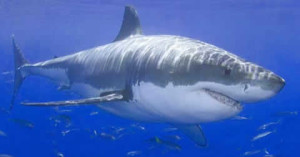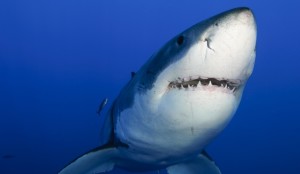Great White Shark Basic Facts:
Diet: Carnivore
Size: 15-20ft (4.5-6m)
Weight: 4000-5000lbs
Life Span: 30 Years
Group Name: School or shoal
Speed: 15 MPH
Photos:
Photography from iStockphoto
The Great White Shark (Carcharodon carcharias) is also known as white death, white pointer, or great white. This shark species is found in all major oceans around the world. It weighs over 5000lbs (2268kg) and matures around the age of 15 years. It has a life span of over thirty years.
Great White Sharks stand out as the largest predatory fish. Their meat is unhealthy and dangerous because of extremely high mercury levels. They live along all coasts except in the Antarctica. Their liver weighs up to 24% of entire weight. Yeah, the liver is that enormous.
The White Shark does not chew their food. They usually swim up at a very high speed out of the water surface and back holding a prey in their mouth. They then rip the meat of their prey and swallow it in whole. After they take a prey like the seal or the sea mammal, they can survive for duration of up to two months without a large meal.
The Great White has an ability to eat a sea lion in whole. They often have scars and scratches due to constant fights with their prey. This shark has the ability to roll its eyeballs back. This protects against scratches. Young sharks are fond of eating leopard sharks.
White Sharks normally breed late in their life. In most cases, they hardly breed until they are 20 years old. They can be able to swim immediately they are born. Once these species are born, together with their siblings, which might be two to twelve in number, they get to swim away from the mother and start living their own life.
They are blue gray in color on their dorsal and top part of the body. This feature helps the predators blend with the bottom area of the ocean especially when viewed from above. Their belly is white making it difficult to view their below part especially when there is sunlight.
The great white shark facts can also include there position in the food chain. They are on top with only larger sharks and the orcas as their predators. However, they are also faced with a treat from the humans who might accidentally catch them in the fish net or people who intentionally fish them for various reasons.
With all these facts the Great White is a great attraction to both tourist and researchers in the marine life. One cannot get to avoid getting astonished at the enormous liver that is oily and containing a weight that is about twenty percent of the entire weight. This is what assists it to float.



